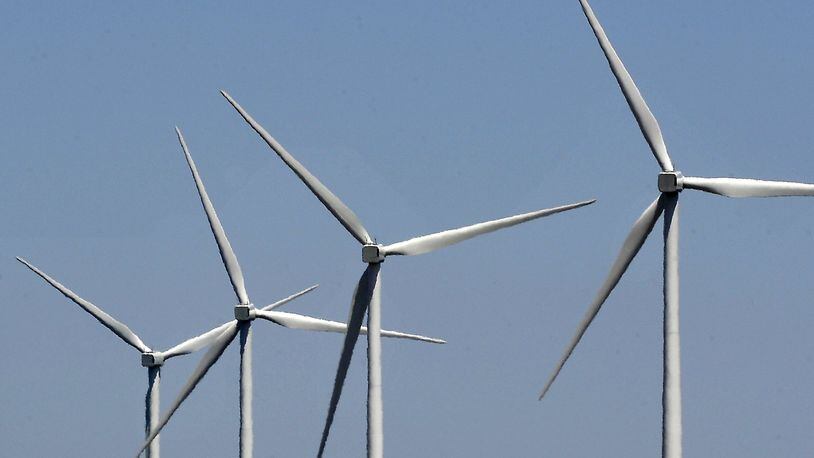Staying with the story
The Springfield News-Sun will continue to provide award-winning coverage of wind energy developments in Champaign County and Ohio. The paper has provided coverage of everything from how the Buckeye wind farm would be taxed to its potential benefits and concerns about safety and property values from opponents.
By the numbers:
100 —Approximate number of turbines in both phases of the project combined
$55 million — Estimated impact of the project
50,000 —Estimated number of homes the project could power in a year
Business officials in a handful of Northwest Ohio Counties are pushing for legislation that will give local governments more control over wind-farm development.
Ohio House Bill 190 would give local governments flexibility to determine how far wind turbines must be set back from neighboring property lines. Those setbacks have been a point of contention between wind developers and their opponents, who have argued strict setbacks are needed to ensure safety of residents in nearby properties.
Under new state regulations passed last year, the turbines are required to be at least 1,125 feet from the tip of the blade to the nearest property line. Several developers said those restrictions will make it difficult to site new projects in Ohio. The proposed legislation would give county commissioners the authority to decide whether to approve projects using the tougher setbacks, or the previous standards which were based on the distance between a turbine and a habitable structure, said Ohio Rep. Tony Burkley, R-Payne, who co-sponsored the legislation.
Amazon, the Internet retailer, announced last week it will partner with EDP Renewables and build a 100-megawatt wind farm in Paulding County called the Amazon Wind Farm U.S. Central. Beginning in May 2017, that wind farm is expected to generate energy to the company’s data centers. That project has already been grandfathered under the previous rules.
“If they had to go by the current setbacks, that wind farm would not be constructed,” Burkley said.
Burkley’s district includes Defiance, Paulding and Van Wert Counties where Ohio’s two operational wind farms are located. Of 17 total projects in the state, only those two are currently producing energy, both of which are in Burkley’s district. As many as 14 elected officials and business leaders in that area have also signed a letter in support of the bill.
In Champaign County Everpower Renewables is seeking to develop two wind farms that would spread about 100 turbines across several townships. Opponents have raised concerns about the safety of that project, and have appealed a state decision to approve the second phase of that project to the Ohio Supreme Court. The court is expected to hear oral arguments in that case next month.Officials from Everpower declined comment because they were not familiar with the legislation.
But in Paulding County, the wind farms have been beneficial and contributed to the local economy, said Peggy Emerson, president and CEO of the Paulding Chamber of Commerce.
“For the chamber of commerce, wind farm up here means jobs,”Emerson said. “It’s just that simple. And it’s a great opportunity for our local area.”
The Buckeye projects have already been approved under the older setbacks. But opponents have appealed a state decision to extend the certificate to build the project, and if the court rules against the project it’s possible the tougher setbacks could apply.
One concern is the proposed bill would allow for shorter setbacks, but not longer setbacks, said Chris Walker, an attorney for Union Neighbors United. UNU is made up of Champaign County residents opposed to the Buckeye project.
Walker also argued there have been cases in which wind turbines have thrown debris further than the current setbacks.
“Our primary concern is the one-sidedness of the legislation, allowing for less stringent setbacks but not allowing for approvel of more stringent setbacks,” Walker said.
Ohio Sen. Bill Seitz, who has been heavily involved in developing rules for the industry, said he would be willing to compromise on some version of the proposed bill. But he said counties often have a vested interest in receiving revenue from the wind farms. Instead, Seitz said he would consider a plan that would allow the townships, villages or cities to decide whether to approve tougher setbacks. He would also seek changes that would require local elected officials to recuse themselves from voting on wind projects if they stand to personally benefit financially. That is not the case now, Seitz said.
“Before I would vote on letting the locals vote on waiving the setbacks, I would want to change state law to say that any of them that are themselves leasing land to the wind farm must recuse themselves from the vote,” Seitz said.
About the Author
